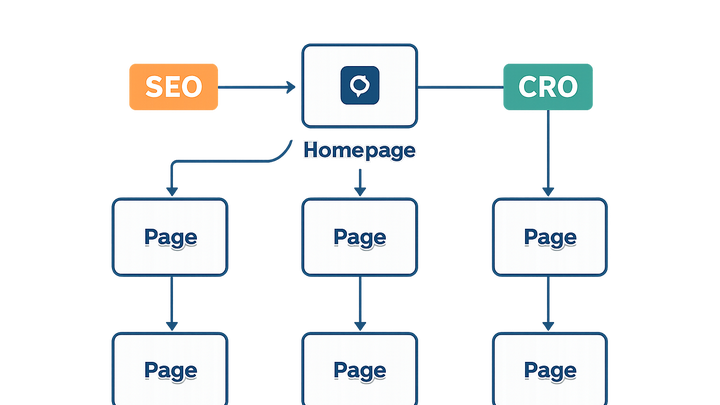Published on 2025-06-29T21:03:57Z
What is Internal Linking? Examples and Best Practices for CRO, UX & SEO
Internal Linking refers to the practice of adding hyperlinks between pages within the same website domain.
It is a cornerstone of effective website structure that impacts SEO, user experience (UX), conversion rate optimization (CRO), and accessibility.
By strategically placing internal links, you distribute authority across key pages, guide visitors toward relevant content, and help search engines crawl and index your site more effectively.
Tools like Prevue.me provide actionable critiques by analyzing your internal link structure, highlighting opportunities to improve navigational paths, fix broken links, and optimize anchor text for maximum lead generation.
Whether you aim to boost organic rankings, reduce bounce rates, or enhance the overall user journey, a well-planned internal linking strategy is essential for driving growth and engagement.
Internal linking
Linking pages within a website to boost SEO, guide users, distribute authority, and improve conversions.
Importance of Internal Linking
Internal linking is crucial for search engines and users alike. By connecting pages across your site, you direct link equity to priority content and make important pages more discoverable. Well-structured internal links help crawlers index your site efficiently, boosting SEO performance. They guide visitors to related information, improving engagement and reducing bounce rates. Furthermore, internal links can optimize conversion paths by directing users toward lead-generation and product pages.
-
Seo boost
Well-structured internal links help search engines discover and index pages more efficiently. They distribute link equity throughout your site, strengthening the ranking potential of target pages.
- Crawl depth:
Reducing the number of clicks needed to reach a page ensures that search bots crawl and index deeper content.
- Link equity distribution:
Strategically linking from high-authority pages passes ranking power to essential content.
- Crawl depth:
-
Enhanced user experience
Internal links guide users to relevant content, increasing time on site and reducing frustration by offering clear navigation paths.
- Breadcrumb navigation:
A trail of links showing the user’s position within the site hierarchy, enhancing orientation.
- Contextual recommendations:
Inline links suggesting related articles or products that keep users engaged.
- Breadcrumb navigation:
-
Conversion rate optimization
By directing traffic to high-value pages like signup forms or product pages, internal links can boost lead generation and sales.
- Optimizing anchor text for ctas:
Use clear, action-oriented text (e.g., ‘Start your free trial’) to encourage clicks toward conversion goals.
- Reducing clicks to conversion:
Limit steps between landing pages and conversion points to decrease drop-off rates.
- Optimizing anchor text for ctas:
-
Accessibility improvements
Descriptive and logical internal links help assistive technologies and support an inclusive user experience.
- Skip navigation links:
Allow users to bypass repetitive menu links and jump directly to main content.
- Descriptive link text:
Ensure each link makes sense out of context, aiding screen reader navigation.
- Skip navigation links:
Best Practices for Internal Linking
Applying industry standards ensures your internal linking strategy is effective, user-friendly, and aligned with SEO, UX, and CRO goals.
-
Use descriptive anchor text
Anchor text should clearly describe the destination page, conveying context to both users and search engines.
-
Maintain a logical site structure
Organize pages into categories and subcategories, linking them to reflect hierarchy and reduce click depth.
-
Prioritize high-value pages
Focus internal links on pages that drive leads, such as product pages, blog posts, or signup forms, amplifying their visibility.
-
Conduct regular audits
Use tools like prevue.me to identify broken links, orphan pages, and opportunities for new internal links to boost engagement.
Common Mistakes to Avoid
Avoid common pitfalls to maintain the health and effectiveness of your internal linking structure.
-
Overlinking
Excessive links dilute link equity, overwhelm users, and can be perceived as spammy by search engines.
-
Broken or redirected links
Links to non-existent or redirected pages harm SEO and frustrate users; regularly monitor and fix these issues.
-
Irrelevant linking
Linking to unrelated content disrupts user experience and weakens thematic relevance for search engines.
Example Workflow with Prevue.me
Leveraging prevue.me’s actionable critiques streamlines the analysis and optimization of your internal linking strategy.
Follow these steps to audit, implement, and test improvements that enhance SEO, UX, and conversions.
-
Site audit setup
Enter your site URL in prevue.me to generate a comprehensive crawl report that maps your internal link network, identifies orphan pages, and spots broken links.
-
Review link recommendations
Analyze prevue.me’s prioritized suggestions for adding or updating internal links, optimizing anchor text, and fixing navigation issues based on SEO and CRO best practices.
-
Implement and test changes
Apply the recommended updates in your CMS or codebase, then use prevue.me to validate fixes and run A/B tests to measure impact on user behavior and conversion rates.
Example code:
<a href="/pricing" title="View pricing plans">View our Pricing Plans</a>
